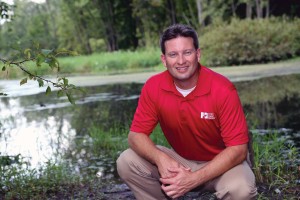
Graduate students in Mary Gardiner’s lab survey vacant lots in Cleveland to determine the environmental
benefits of different landscape treatments being studied.
Decades of population losses have left the city of Cleveland with 3,600 acres of vacant land, while some 1,000 homes are demolished every year.
Currently, Cleveland plants turfgrass on empty lots, but it’s expensive to maintain and offers few benefits. “Alternative plant communities could offer greater environmental benefits such as support of biodiversity and improved storm-water infiltration to reduce flooding,” said Ohio Agricultural Research and Development Center entomologist Mary Gardiner.
Last year, Gardiner started a large-scale, never-before-attempted project that examines the impact of eight different landscape treatments on the biodiversity and ecosystem function of 64 empty lots in eight Cleveland neighborhoods. The five-year project’s main goal is to gather data that will inform future green space design in Cleveland and other cities engaged or interested in vacant-land management.
“With the right combination of plants and increased ecosystem services, urban vacant land can be seen as an asset for community development rather than as an eyesore,” Gardiner said.
Essentials
- This project is funded by a highly competitive $909,200 Faculty Early Career Development Program grant from the National Science Foundation, which promotes the integration of research and education.
- Part of the project includes the development of a high school science curriculum for use by teachers in Cleveland and throughout the state. The lessons focus on insect-predator-prey relationships and teaching students how to collect data and communicate their findings using scientific arguments.
- A related program involves the training of Master Gardener volunteers on issues related to urban farming. These volunteers will then teach Cleveland residents best practices for growing fruits and vegetables on converted vacant land, fostering new economic opportunities and healthier eating.
- Students in Gardiner’s lab are also studying the benefits of rain gardens in the city of Cleveland, including their contributions to pollinators, soil health and storm-water cleanup.
“Working on ecological research in city neighborhoods requires advanced scientific knowledge and excellent people skills,” said Terry Schwarz, director of the Cleveland Urban Design Collaborative. “Mary embodies both of these things. Her work has the potential to impact people’s lives in tangible and lasting ways, and to contribute to new ways of thinking about Cleveland.”
